Friday Night on the A55, and other North Welsh Comments
The Key road in North Wales is the A55, a dual carriageway that takes the traffic from the end of the M56 and winds it past the coast, quite spectacularly in some cases, before joining with the old A5 if one crosses the Menai Straits to Anglesey. Working south of Manchester, and finishing around lunchtime on a Friday, and fixtures down this road are easy to get to. Friday night football is not rare in Wales, but most of the grounds staging it are floodlit and return again and again. It is only at the start and end of season that there is some variety. And so I found myself running down the road two Fridays in a row, at the end of August. Despite supporting many resorts, the traffic was not overtly heavy on either date, and so my runs were simple in themselves.
On the North Welsh coast, the jewel is Llandudno, a resort made popular in Victorian times, and with the imposing hotel frontages along the bay. If you look on the internet, many of these hotels still charge quite high rates despite a tiredness and lack of recent investment. If you go beyond the room rates to the reviews, the words “Don’t stay here!” turn up with alarming frequency.
Coming from England, the seaside towns between the border and Llandudno are brasher, dependent more on the working class shilling brought in by the railways. None more so than Rhyl, which does its best to be a mini-Blackpool on the North Welsh coast even if its equivalent of the golden mile appears to be no more than 400 metres, and then in nickel, flashing glaringly at those driving along the coast road.
There is still a lot of business here over two million visitors a year, although as most of them are day trippers or staying for a single night, the local economy is always has one eye on the weather forecast in an area where the weather can change (and never for the better) at the drop of a hat.
Missing the grandeur of Llandudno and the brashness of Rhyl, I ended up in Prestatyn. This is a more comfortable town, but with little except a beach to welcome the visitors. The Halcyon Quest Hotel is in the Good Beer Guide, but would never make a good hotel guide. Still, it was not overpriced, the landlord (when he arrived) was welcoming, the beer and the breakfast were both good and I slept well.
My first game of the weekend was Kinmel Bay Sports, formerly known as Abergele Rovers, but now based (playing wise) at the local leisure centre, and (socially) at the Kinmel Bay sports and social club. Unusually the change in name and venue marks a merger with a local Girls team! They have benefited from recent changes in the Welsh Pyramid and have found a place in the second division of the Welsh Alliance. They may not have to finish particularly high to get promoted this season. The Cymru Alliance, which covers the Northern two thirds of the principality, wants to expand from one division to two, while the FA of Wales wants to re-arrange the borders between the Welsh Alliance, and the Welsh National League (Wrexham), with the latter taking on those Welsh Alliance clubs in the North East Wales area. I am not sure exactly what this means, but I am told the line between the two leagues will be drawn just east of Prestatyn, and will take a small number of teams out of the Welsh Alliance.
On arriving at the ground, the first thing I saw was a couple of the other groundhoppers attracted by the Friday night game here. A slightly odd choice as rather than avoiding a clash, they were now playing at the same time as both Rhyl and Prestatyn. We also had the dubious pleasure of being able to hear the sounds of a nearby funfare. To be honest, this is not one of the more interesting grounds on my trips. The dressing rooms were built into the leisure centre, with the referee and his assistants changing somewhere inside, and then locking their bags into their car, demonstrating a lack of confidence in the security provided.
Three officials are not always provided in this league, but Liam Gray showed some initiative in this respect, bringing both his father and grandfather along to run the lines. I cannot recall ever seeing three generations of the same family officiating at a single game. Liam is a young referee, quite recently called to officiate in the Welsh Alliance. Not surprisingly he also has an older brother, currently refereeing in the Cymru Alliance.
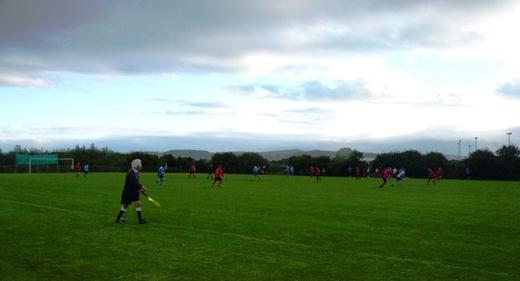
The Referee’s Grandfather is in the foreground
Most of the surrounds to the playing surface were closed to the public, no spectators at either end, and the far side was used only for the team benches. Near to the centre, there was a wooden barrier, where the majority of the crowd (counted at 34) gathered. From about a third of the way town, the pitch-side became a cage enclosing floodlit tennis courts. There were a couple of more open pitches further away and beyond the tennis courts.
A strong wind blew across the pitch throughout the game, making the evening very cool, but at least we did not suffer rain, as there was no shelter to be had. I thought the home side had the better of most of the game, but they went behind to a first half penalty and only levelled when an on the line clearance was adjudged just over by the well placed linesman. We were charged £1 for a programme, but no admission charges for what does not get above being a public park. The only refreshments were a vending machine within the centre, offering a 50p coffee. I needed the warmth, as the match itself was doing little to raise the temperature.
Llandyrnog United led at half time, thanks to a penalty shortly before the break, Kinmel Bay levelled with 15 minutes to play and that is how the game finished. Dropping one other hopper near a railway station, I found my way back to the hotel and had a couple of pints before turning in. Another of the hoppers actually stayed at the same place, but I did not see him again until morning.
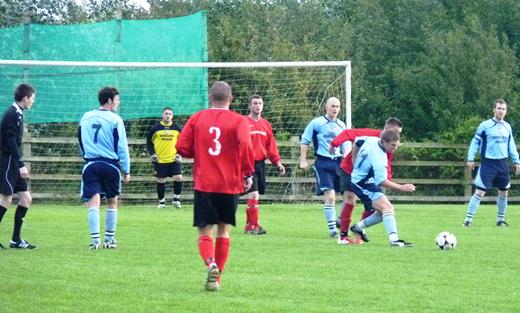
On a greyish morn, where the threat of rain was always made, but never quite delivered, I made my way to Penrhyncoch. This is a small village not far from Aberystwyth in the centre of the country. The distance is not much over 80 miles, but as an indication of the difficulties that Welsh football suffers, it took me around two and a half hours to complete. This is similar to the journey Llandudno had to make for the game I saw, and trips that Penryncoch make on a pretty regular basis. I only counted 50 people at the game, (the official attendance figure was 70), and I can be sure that not all of them paid the full £4 admission, and a further pound for a programme. It is hard to see how this club is surviving, and to create a second division can do nothing to improve the standard of football in this part of Wales, it is surely more of a bid by league officials to make the own competition seem more important.
Cae Baker is a smallish ground, quite tidy with a two separate covered areas, one providing around 50 seats, the other had standing for a similar number of people. On that side, there is plenty of space, but when I wandered around the other side for the second period, I was amazed how tight the space was, with a small area where there was no spectator space at all and then a very narrow grassway. The biggest thing that this club has is a very good clubhouse, just across the road from the ground, (this may be the main road, but there are no busy roads in Penryhncoch).
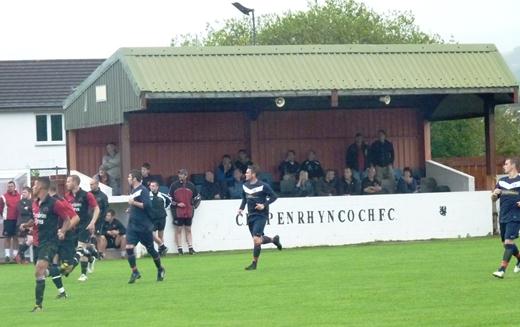
Note the club name on the stand, CPD Penrhyncoch FC, CPD being the Welsh equivalent of FC. The same dual usage is a feature in the programme and elsewhere at the club
As the match started, we finally got the heavy shower we had expected, and I went to the back of the seated area to view the game. I thought Llandudno edged the first period which ended scoreless, and seeing how they allowed the ball to run away from them, I was expecting better after the break when they were to play up the slight incline. In the first four minutes, Llandudno had two chances, and I thought I was right, but then Penrhyncoch scored a long shot from Josh Shaw. This completely changed the complexion of the game, and the homesters will count themselves unlucky not to have added two or three more, while the visitors never threatened again. As it was, 1-0 was the final result.
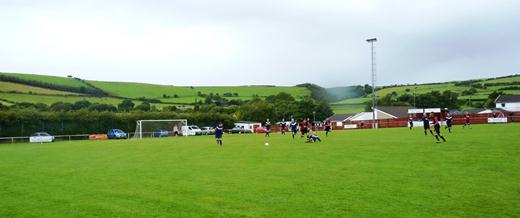
The small cover which sheltered me from first half rain is to the right, with the main stand out of shot
This was not my final match of the day, as there is a regular evening fixture in the Mid-Wales League (South). The match is St. Harmon & District v Rhayader Town (reserves). I had seen this fixture in 2009, and said I would not bother to return in poor weather, (no cover at the ground), but it had brightened up as I drove east along the A44, and so I went along. On arriving at St. Harmon, I noted the figure on my odometer as I passed the Sun Inn, used for dressing rooms. One then drives for over a mile, past the showgrounds, (it is the local show that causes the late kick off time), and left for about a quarter of a mile along a narrow drive (hoping no one is coming the other way). A mere 1.8 miles from the dressing rooms, you arrive at the playing fields. Parking is in the farmer’s yard opposite the ground entrance. I know of no ground further from its dressing rooms than this one. Some people I know have seen St Harmon on a different ground, closer to the main road, but this too was over a mile from the Sun Inn.
Despite only offering a roped off field, this match had the largest of the three attendances for my games over this two day period, based at least on my own head counts. Both the Cymru and Welsh Alliance websites official showed figures well in excess of my numbers, whereas there is no official figure for St. Harmon. For the record, I put the number down as 68 hardy souls paying £2 to view this game on an unsettled evening, which at least stayed dry.
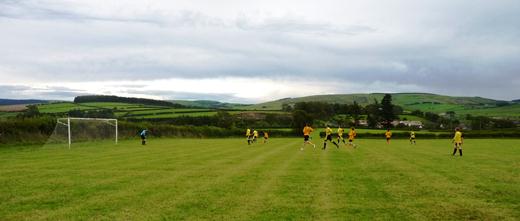
St Harmon the joys of fields in Wales
When I came two years ago to the same match, it was level (2-2) at half time, but then Rhayader scored three without reply in the second period. This time the difference was the game was scoreless on turning around. Rhayader still scored their three goals after the break.
A week later, I was back in the principality, but this time travelling further along the North Coast before dropping down to avoid reaching the Menai straits, and ending up in Caernarfon. I had visited Caernarfon Town in the mid 1980s, when the club were at the top of the game. They had entered the Lancashire Combination in 1980, and as 1982 Champions, they became founder members of the North West Counties League, initially in Division Two, but winning promotion after only one season. Two seasons later, they won a further promotion and were in the Northern Premier League. I visited them in 1986, the first of two seasons when they finished third in the league, and they may have believed a place in the Alliance (now Football Conference) awaited. To make the matters of their best season better, my visit was for a second round FA Cup match. Stockport County had been beaten in Round 1, and despite the fact I saw a scoreless draw, Caernarfon then won the replay at York to reach the 3rd Round, (they drew 0-0 to Barnsley, and lost 1-0 in the replay this time).
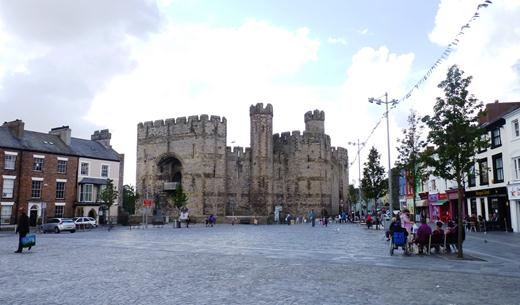
The decline of the club has been almost as rapid. They were relegated in 1990, to the Northern Premier’s first division. They came close to returning after one season, but then the FA Wales threw the spanner into the works, insisting that Welsh clubs were no longer permitted in the English pyramid. Caernarfon were one of the clubs that resisted the change, and spent three seasons as exiles, with home match being played on English soil. When the Welsh clubs finally won their court case in 1995, it was too late for Caernarfon, and instead of returning home in the NPL, they instead joined the League of Wales. Except for one season in the Cymru Alliance they stayed in the League of Wales (later Welsh Premier League) until 2009. They then again spent only one season in the Cymru Alliance, but this time left through the wrong door, and so now find themselves at the third level, the Welsh Alliance.
But not everyone has suffered from the vagrancies of Welsh Football Politics. Caernarfon Wanderers gained a place in the Welsh Alliance’s second division, founded a season ago and partly offsetting the FA of Wales’ demands for smaller divisions. After a single promotion they are in a position to challenge their neighbours, with the first ever Caernarfon derby at League level.
With its well preserved castle, and city walls, Caernarfon is a fine city to visit on a Sunny afternoon. However, if one climbs less than a mile outside the walls, one comes across a dismal housing estate. On the edge of this estate is Cae Top. It seems to me that there is a habit of mixing English and Welsh words in the naming of football grounds in these parts. Certainly the words Top (Caernarfon Wanderers) and Baker (Penryncoch) do not sound very Welsh, so should I presume to semi-translate them as Baker’s Field and Top Field? If so, I could remember I have already been to a ground called the Top Field, to see Hitchin a team playing in Yellow and Green and nicknamed the Canaries. Familiar ground maybe for the Caernarfon Town fans.
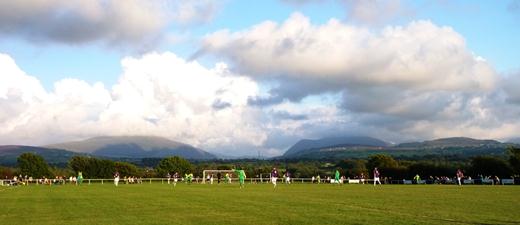
Anyway, Cae Top is a simple, railed off pitch, and not fully enclosed. Slightly down the hill, new School buildings are in the process of construction, and this has led to a freshly tarmacked driveway down one side of the pitch which leads to a new car park, currently fenced off behind one goal. This is destined to become a staff car park for the School, but with few matches on school days, and especially not during school hours, one hopes the Football Club will also be permitted to use it.
The club currently has a small stony car park, and it was clearly going to fill quickly, I settled for street parking just outside, making sure to leave plenty of space for the frequent bus service around the corner. The officials of both clubs were very friendly and helpful. One of the visiting officials explained the Caernarfon Town club was being rebuilt on a more financially sustainable basis and with a more local accent. All but one of the players are now Welsh speakers. This contrasts greatly with the old style for some of the bigger clubs in this part of Wales, were a Liverpudlian accent was more common than a Welsh one. Indeed, while the costs of renting grounds and losing spectators did not help the club during their exile, players’ expenses may well have been lower!
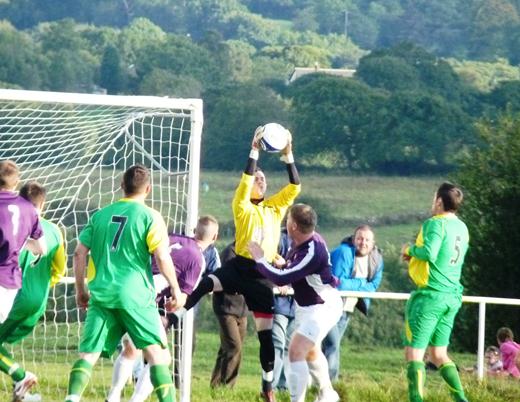
As for the game, Wanderers may have pulled level in terms of status, but they were still behind on playing strength. For thirty minutes, some wasteful finishing kept the visitors out, but then they pushed on and eventually won by four goals to none. It will still go down as a good day for the home side, with a crowd of around 500, easily the best seen at Cae Top. For me, the biggest downside of travelling this far from home for a Friday night game, is the drive home, so I welcomed a the fact that Steve Munday, who I had met in the town earlier travelled back as far as Birmingham